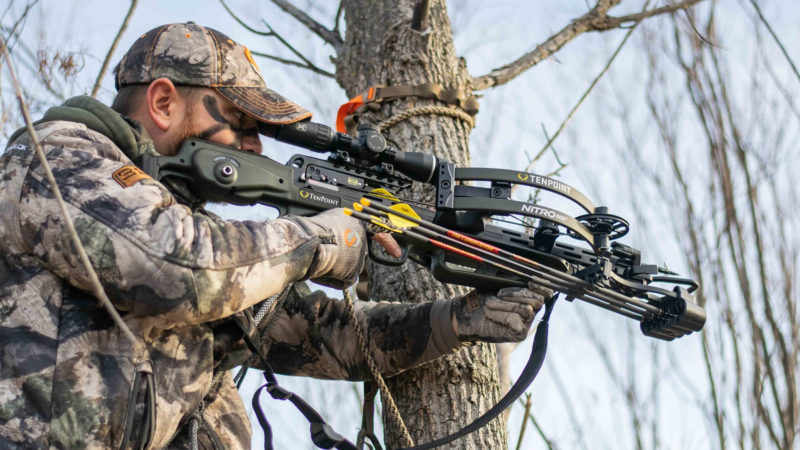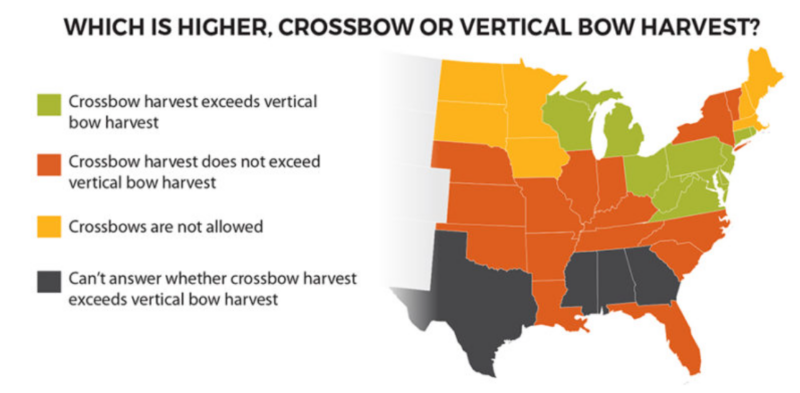Hunting technology continues to evolve, and in the past 40 years, few technological advances have been more controversial than the crossbow.
The impact of modern crossbows on the hunting industry has been profound, in both positive and negative ways. While many have seen the crossbow as an opportunity, others have feared its impact on the bowhunting tradition and wildlife management.
Of course, with every new technology comes a shift in mindset, and certain factions will naturally rebuke it.
In that respect, crossbows today are no different than the popularization of compound bows 30 years ago. Many of the fears raised by traditional bowhunters regarding the compound bow back then are issues currently being raised by compound bow users when they talk about crossbows today.
But what is true and what is just fear mongering?
Let’s look at the pros and cons of crossbows in the hunting industry and then take a deep dive into how they’ve impacted whitetail management.

The Pros of Crossbows
Crossbows have provided an easy point of entry for youth as well as senior hunters to experience and enjoy one of the best times of year to be in deer woods – archery season.
The shift in demographics and availability of crossbows has made hunting more inclusive, allowing individuals who may have physical limitations or less experience with traditional archery equipment to enjoy the sport.
In fact, crossbows help address two major concerns in the hunting industry: how to introduce more young hunters to the sport and how to accommodate an aging population.
The rise of crossbow use has not only affected deer harvest numbers in some states but also shaped the broader hunting industry.
The increased demand for crossbows has led to innovations in crossbow technology, including lighter materials, quieter mechanisms, and greater accuracy.
We now have a wide range of crossbows that cater to different skill levels and preferences, from beginner-friendly models to high-end, proficient tools capable of shooting accurately out to 100 yards.
Sales of crossbows and related accessories, including bolts, scopes, and cocking devices have provided archery shops with more opportunities to increase their income. And the market shows no signs of slowing, as it’s predicted by Maximize Market Research that crossbow sales will continue to grow by 7% from 2024-2030.
These sales are also a boost for the Pittman-Robertson Act, established in 1937, which collects a federal excise tax on the sale of firearms (11% on long guns and 10% on handguns), ammunition (11%), and bows and certain archery equipment (11%). The collected taxes are annually apportioned to each state to enhance wildlife restoration, conservation, hunter education, and other programs beneficial to all sportsmen and women.

The Cons of Crossbows
Not all hunters view crossbows as a blessing. In fact, many have spoken out against the negative impact of crossbows on the hunting industry, wildlife management, and the tradition of bowhunting. Crossbows, after all, require fewer skills or practice to become proficient with. This creates an interesting concern among many experienced bowhunters: new hunters who have only ever used a crossbow cannot truly appreciate the greater challenge associated with using a vertical bow.
Crossbows have eliminated the need for constant practice to improve shooting mechanics and accuracy. Sight in the scope and you’re good. Most scopes on modern crossbows are range-finding and can be dialed into bull’s-eye at 100 yards with an appropriate rest. These capabilities are not the typical limitations of primitive weapons.
Also, a pre-cocked crossbow eliminates the movement needed to come to full draw on an animal, which is arguably the hardest part of using a vertical bow. Crossbows also invite the use of a solid shooting rest and are more versatile for use in all types of hunting blinds. While these are all pros as far as crossbow hunters are concerned, these are the same advantages as firearms, and so have detracted from the tradition associated with vertical bowhunting.

Statistical evidence shows that crossbows have slowly eroded the tradition of hunting with a vertical bow in some states, too, as reflected in the deer harvest according to weapon of choice.
The National Deer Association (NDA) reports, of the 30 states east of the Rocky Mountains, 25 of them distinguish crossbows and vertical bows in their deer harvest figures.
Of those 25 states, crossbow harvests exceed those of vertical bows in 11 of them.
It should be noted, though, that many states also restrict crossbow use to disabled or senior hunters or only permit it during modern firearms seasons, so the harvest is naturally suppressed in those states compared to states that allow widespread use.
Check out the NDA chart below for a closer look.

Crossbow Harvest Trends
The NDA reports a total of 9.5 million deer hunters in the contiguous United States, of which 3.5 million are archery hunters. The report also breaks down harvest figures across the country by region as well as bowhunter success rates: Northeast (35% success rate), Midwest (28%), Southeast (16%), and the West (9%). Interestingly, the state with the highest success rate among archery hunters was New Jersey (64%), and rounding out the top five were Connecticut (58%), Massachusetts (50%), Ohio (48%), and Illinois (46%).
The three states with the highest concentrations of bowhunters are Pennsylvania (334,000), Michigan (322,000), and Wisconsin (309,501). These three states also started out restricting crossbow use to special permit holders but legalized them for statewide use by every bowhunter who chose to use one in 2009, 2009, and 2014 respectively.

A Closer Look at Pennsylvania
Going strictly according to total harvest figures, it’s hard to argue that crossbows have made any impact to the total harvest. In 2009 in Pennsylvania, the first year of legalized statewide crossbow use, the total harvest was 308,920 and continued to stay below the previous 10-year average until a spike in the 2020-21 harvest. Research shows that total harvest is typically correlated with license sales and hunter participation rather than choice of weapon.
However, the interest in crossbow hunting was felt almost immediately. Now legal to use statewide, Keystone State hunters began turning to them more and more. Prior to 2009, crossbows were only permitted in three urban hunting units in Pennsylvania. The first year of statewide legalization saw an increase from 15% to 30% in the number of deer taken with a crossbow. By the 2019-20 season, crossbows accounted for 68% of the archery harvest, according to Pennsylvania Game Commission surveys, and that number has stayed consistent ever since.
Another interesting point to consider is that archery has accounted for a higher percentage of the total harvest in Pennsylvania every year since crossbows were legalized. In 2009-10, archery accounted for approximately 23.7% of the overall harvest. In 2023-24, archery accounted for 36% of the harvest. Pennsylvania Game Commission surveys now show that 68% of Keystone State archers use a crossbow.

Similar Results in Other States
Other states have seen similar results. Ohio was one of the first states to legalize crossbows for statewide hunting in 1982, and within just 7 years, crossbow harvests exceeded vertical bow harvests. Today, crossbows account for over 70% of the archery harvests in Ohio, too.
Another Midwestern state, Illinois, has seen a similar trend. Crossbows were legalized for every hunter, not just for the disabled, in 2017. According to harvest data by Hunt Illinois, the crossbow harvest hovered around 10-15% prior to 2017. In 2017, it jumped to 30.2%. By 2023, it had climbed to 53.4% of the overall archery harvest.
In fact, across the board, states that have legalized crossbows in the past 10-15 years have seen similar trends in harvest statistics. The combination of ease-of-use and accessibility has made crossbows a natural choice for new archery hunters young and old, and even more experienced hunters are turning to them more every year.

Are We Shooting More Deer Now?
One of the concerns of more crossbows is that they are inherently more effective. Studies show that hunter success rates with crossbows are 2-10% higher than those who use vertical bows. That’s a relatively insignificant advantage considering that hunters today harvest over 8.2 million deer every year across the United States.
Again, the most significant factor in total harvest is hunter participation, as evidenced by the “Covid spike” in 2020, when more people turned to the outdoors to escape the pandemic. States like Pennsylvania, Illinois, and many others experienced increased harvest totals that year. Since 2020, statistics have steadily dropped back to pre-Covid levels.
It’s interesting to point out, though, that the 2011 NDA report states that deer harvest totals in 1999 and 2009 were nearly identical at around 6.5 million whitetails. So yes, we are killing more deer today overall, but we also have longer seasons, increased antlerless tags, and more opportunities to hunt, so it’s difficult to point to crossbows as the singular reason we’re killing 1.7 million more deer today than 15 years ago. But if nothing else, crossbows have allowed more hunters to participate in those longer seasons and take advantage of those opportunities.

The latest state to legalize widespread crossbow use for everyone is Minnesota. 2023 was their inaugural season, and Todd Froberg, the Minnesota DNR’s big game program coordinator was quoted in the Duluth New Tribune as saying, “We did see a 6% increase in total archery sales in 2023 over 2022, and we think that’s probably because of crossbows.”
According to Froberg in the article, the biggest jump in archery harvest came from youth under age 17 and adults over age 55, and the vast majority of deer harvested by archery hunters over age 55 were by crossbows, not vertical bows. However, as with other states, Minnesota’s overall harvest figures remained relatively similar to previous years.
Are Crossbows More Ethical?
Many hunters choose crossbows for their obvious advantages. Greater accuracy, less practice required, versatility in the field, and long range possibilities. Granted, although a crossbow is capable of 100-yard accuracy doesn’t mean hunters should take shots that far.
A 2014-15 survey of Ohio archers attempted to determine whether crossbows or vertical bows produced more wounded deer. Surveys were sent to 3,044 participants and only 681 (22.4%) returned a completed survey. Still, the results are interesting.
According to survey results, the average shooting distance for hits with a crossbow was 22.4 yards compared to 22.6 yards with a vertical bow. The average miss was 31.6 yards and 31.1 yards, respectively. According to the survey, crossbow users had a 73.6% accuracy rate compared to vertical bows at 67.6%. Crossbow hunters also had a higher recovery rate of deer they shot at, 60%, compared to vertical bow users at 56%. Overall, the wounding rate averaged out to 18.5%, but traditional bows (longbows, recurves, etc.) produced the highest wounding rate at 30%.

The Ohio bowhunter survey also proves another point – it’s not the type of bow that makes a hunter successful; it’s their ability to read deer sign, set up their stands, and get within bow-range that ultimately determines how successful they are.
Scott Mook from Tri-State Deer Tracking in Oil City, PA, has been tracking wounded game with dogs for 6 years. In 2023 alone he took 80 tracks for clients and recovered 40 of them. “November is my busiest time,” says Mook. “During the rut, I’ll do 3-4 tracks every day, 7 days a week.”
When asked if most of the deer he tracked were shot with crossbow or vertical bow, Mook says, “It’s split. I’ll get 2 or 3 calls for deer shot with crossbow and then a string of calls for compound. I even do a few for deer shot with longbow or recurve. But overall, crossbows make up about half of the calls I get.”

Mook says that recovery rates for deer shot with crossbow versus vertical bow are about equal, and weapon of choice is second to the skills and decisions made by the shooter.
“Both crossbow and vertical bow hunters make poor judgments,” he says. “They try to rush things and force the shot. Most of the time, they’re just taking shots that are too far. Just because a manufacturer says a bow is accurate at 100 yards doesn’t mean you should shoot 100 yards.”
“I’m finding guys trying to take 50-60 yard shots and they’re not getting their deer. Keep your shots less than 30 yards, and you’ll have a better chance of recovering your deer, regardless of the type of bow you shoot.”
Conclusion
Crossbows are here to stay, and more hunters will continue using them where legal. And that’s not such a bad thing. After all, they are ideal tools for getting youth involved in the sport as well as for extending the archery careers of many aging hunters.
For many years, archery was considered a somewhat exclusive pursuit. It took extensive amounts of time and patience to get proficient with a bow. It somehow seems unfair that crossbow hunters can purchase a bow and have perhaps more accuracy and versatility in a matter of hours. But that’s how evolution works in our society. What once was difficult becomes easier with each technological advancement.
The important thing to remember is that we’re all hunters, and we all want the same thing. We want to hunt and kill game efficiently and humanely, and above all, enjoy the time spent in the woods while doing so.

 By
By 



